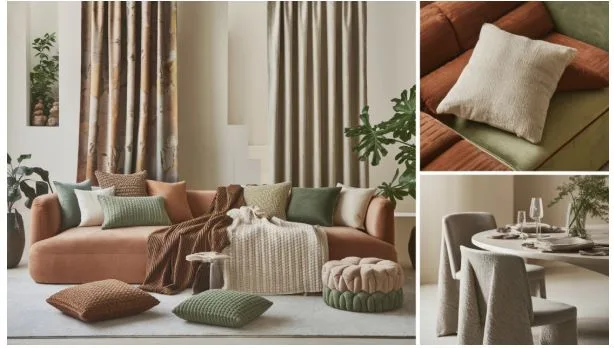Fabric for Upholstery: Eco-Friendly Design Influence
In recent years, the concept of eco-friendly upholstery fabrics has become more popular. This shift towards sustainable and green upholstery fabric choices reflects a larger trend in interior design, where the focus is on reducing environmental impact and embracing materials that are kind to the planet. Eco-friendly design is not just a passing fad; it’s becoming a crucial aspect of modern interior decor. By choosing sustainable materials, homeowners can contribute to a healthier environment while also creating beautiful, comfortable spaces.
The Evolution of Upholstery Fabrics
Upholstery fabrics have a rich history that dates back centuries. Traditionally, these fabrics were made from natural materials such as wool, cotton, and silk. Over time, new technologies brought in synthetic options that were strong and cheaper. However, the environmental impact of these synthetic materials has led to a renewed interest in eco-friendly alternatives.
The evolution of upholstery fabrics is marked by a growing awareness of sustainability. Historical trends have led to today’s eco-friendly designs, as seen in the shift back to natural fibers and sustainable production methods. For a more detailed look into the history and development of upholstery, you can explore the comprehensive insights provided by Britannica.
As designers and consumers become more conscious of the impact on the environment of their choices, the demand for sustainable upholstery fabrics continues to rise. This movement is not just about aesthetics; it’s about making responsible choices that benefit both people and the planet.
Understanding Natural Fiber Upholstery Fabric
Natural fiber upholstery fabric has become popular because it is good for the environment and can be used in many ways. These fabrics are derived from plants and animals, offering a sustainable choice for furniture upholstery. Here are some key benefits and examples:
- Benefits: Natural fibers are biodegradable, reducing environmental impact. They are also breathable, providing comfort and durability.
- Popular Natural Fibers:
- Cotton: Soft and durable, cotton is a popular choice for upholstery. It is easy to dye and blends well with other fibers.
- Linen: Made from flax plants, linen is known for its strength and natural luster. It is also highly absorbent and dries quickly.
- Hemp: This fiber is exceptionally strong and resistant to wear and tear. Hemp grows quickly and requires minimal pesticides, making it a sustainable option.
- Eco-Friendliness: These materials are considered eco-friendly because they are renewable, require fewer chemicals in production, and contribute to a healthier indoor environment.
Benefits of Green Upholstery Fabric
Choosing green upholstery fabric offers many benefits for both the environment and your health. Here are some of the key benefits:
- Environmental Benefits:
- Reduced Chemical Exposure: Green fabrics are often free from harmful chemicals, reducing pollution and chemical runoff.
- Sustainability: Many green fabrics are made from renewable resources, ensuring a lower carbon footprint.
- Health Benefits:
- Improved Indoor Air Quality: Using fabrics with fewer chemicals can lead to better air quality inside your home.
- Allergy Reduction: Natural and chemical-free fabrics are less likely to trigger allergies or irritate sensitive skin.
For a deeper understanding of the environmental impact of different fibers, recent studies on natural and synthetic fibers provide valuable insights into how choosing the right materials can make a difference.
Exploring Durable Upholstery Fabric Options
Selecting durable upholstery fabric is essential for making sure furniture lasts long and looks good, as these fabrics are designed to withstand daily wear and tear. Here are some characteristics that make a fabric durable and suitable for upholstery:
- Tight Weave: Fabrics with a tight weave are less likely to get damaged or wear out fast.
- High Thread Count: A higher thread count often indicates a denser, more durable fabric.
- Material Strength: Natural fibers like wool and jute are known for their strength and resilience.
Examples of durable upholstery fabric include:
- Wool: Naturally stain-resistant and durable, wool is an excellent choice for high-traffic areas.
- Jute: Known for its strength, jute is an eco-friendly option that adds a rustic charm.
Durability contributes to sustainability by extending the life of furniture, reducing the need for frequent replacements, and minimizing waste.
The image showcases a sophisticated and eco-conscious living room featuring plush sofas and drapery upholstered in GOTS- and OEKO-TEX-certified fabrics in rich greens, browns, and beiges, accented with decorative pillows and subtle greenery, all bathed in natural light from large windows, creating a serene and sustainable atmosphere.
Choosing the Right Upholstery Material for Sofas
Selecting the right upholstery material for sofas involves finding a balance between look, comfort, and how it affects the environment. Here are some factors to consider:
- Texture: Consider how the fabric feels to the touch. Softer textures like organic cotton upholstery fabric offer comfort, while rougher textures might add a unique style.
- Durability: Evaluate how well the fabric can withstand daily use. Durable options like wool and jute are ideal for busy households.
- Environmental Impact: Opt for sustainable upholstery fabrics such as natural fiber upholstery fabric. These materials are often biodegradable and have a lower environmental footprint.
When comparing materials, consider the benefits of natural fibers like cotton, linen, and hemp, which are known for being eco-friendly and comfortable. Synthetic options might offer cost benefits but often lack the sustainability of natural alternatives. Ultimately, the choice of upholstery sofa fabric should reflect both personal style and a commitment to environmental responsibility.
The Role of Weaving Techniques in Upholstery
Weaving techniques play a crucial role in determining the texture and durability of upholstery fabrics. Different weaving methods can greatly affect how a fabric feels and how long it lasts, making them an essential consideration for anyone looking to invest in quality furniture upholstery fabric.
Here are some common weaving techniques used in upholstery fabric production:
- Plain Weave: This is the simplest and most common weaving technique. It involves interlacing the warp and weft threads in a crisscross pattern. Plain weave fabrics are known for their durability and are often used in sofa upholstery cloth.
- Twill Weave: Recognizable by its diagonal rib pattern, twill weave adds strength and texture to the fabric. This type of weave is often used for durable upholstery fabric, providing a soft yet robust texture.
- Satin Weave: Satin weaving creates a smooth and shiny surface. While it offers a luxurious feel, it is less durable than other weaves, making it more suitable for decorative cushion fabric rather than high-use furniture.
Understanding these weaving techniques helps in selecting the right upholstery material for sofas and other furniture, ensuring both aesthetic appeal and longevity.
For your upholstery needs, check out Two Sisters Ecotextiles.
Chemical Free Fabric and Its Importance
Chemical free upholstery fabrics are becoming popular because they are healthier and better for the environment, offering a safer choice for households.
Here are some key benefits of using chemical free upholstery fabric:
- Health Benefits: Without the presence of harsh chemicals, these fabrics reduce the risk of skin irritation and respiratory issues. This is particularly beneficial for families with young children or pets.
- Environmental Impact: Chemical free fabrics are often produced using sustainable methods that have a lower environmental footprint. This aligns with the growing consumer demand for green upholstery fabric options.
- Quality and Comfort: Natural upholstery fabric, such as organic cotton upholstery fabric, often provides a softer touch and more breathable surface, enhancing comfort.
Choosing chemical free fabric is not only a step towards a healthier home environment but also a commitment to sustainable living.





